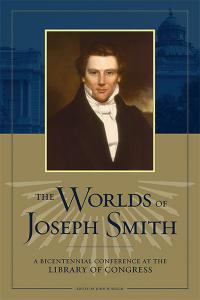Six years ago today I posted comments about The Worlds of Joseph Smith on one of my old blogs. This was an important conference held at the Library of Congress in 2005. Leading scholars, LDS and non-LDS, presented Joseph Smith to the world.
Not surprisingly, given the organizers and participants, they portrayed the Book of Mormon as a Mesoamerican document, thereby framing Joseph Smith and his associates as ignorant speculators who misled the Church, and the world as a whole, about such teachings as (i) Cumorah is in New York, (ii) the Indians of this country are Lamanites, and (iii) the midwestern United States are the “plains of the Nephites.”
In the ensuing six years, there have been hundreds of thousands of page views of my blogs, so for all those new readers, I’m updating and reposting that piece today.
_____
Before doing so, I point out the volume contains a “Gallery Display” of items that were “mounted in the foyer and display cases of the Coolidge Auditorium by the Library’s Exhibition Office.” p. 119. Here are some of the items on display reproduced in BYU Studies:
p. 130: Page of the Original (Dictation) Manuscript of the Book of Mormon, 1829.
p. 131: Diary of William Wines Phelps, Containing a Transcription of Moses 1, 1835.
p. 132: A Page from John Lloyd Stephens, Incidents of Travel in Central America, Chiapas, and Yucatan (New York, 1841).
p. 133: “Zarahemla,” Times and Seasons (October 1, 1842, p. 927).
The next time some M2C proponent tells you the 1842 Times and Seasons article isn’t really all that important, ask why it was put on display in the Smithsonian along with the original manuscript of the Book of Mormon. Ask why they displayed the illustration from Stephens’ book instead of Letter VII.
Far better would have been to display something Joseph actually wrote, such as the Wentworth letter, or Joseph’s letter to Emma during the Zion’s Camp march, than to display an article Joseph didn’t even claim.
——
Clark’s article starts on page 83. I’m not going to reproduce the whole thing here, just a few sections in blue that I’ll comment on in red. Bolded emphasis is mine.
p. 85: Most Mormons fall into a more subtle error that also inflates Joseph’s talents; they confuse translation with authorship. They presume that Joseph Smith knew the contents of the book as if he were its real author, and they accord him perfect knowledge of the text. This presumption removes from discussion the most compelling evidence of the book’s authenticity–Joseph’s unfamiliarity with its contents. To put the matter clearly: Joseph Smith did not fully understand the Book of Mormon. I propose that he transmitted to readers an ancient book that he neither imagined nor wrote.
One thing all readers share with Joseph is a partial understanding of the book’s complexities. Indeed, many things about the book were simply unknowable in 1830. Over the last sixty years, Hugh Nibley, John Sorenson, and other scholars have shown the Book of Mormon to be “truer” than Joseph Smith or any of his contemporaries could know. Consequently, what Joseph Smith knew and understood about the book ought to be research questions rather than presumptions. Thanks in large part to his critics, it is becoming clear that Joseph Smith did not fully understand the geography, scope, historical scale, literary form, or cultural content of the book.
For example, early Mormons believed Book of Mormon lands stretched throughout all of North and South America, a presumption clearly at odd with the book itself (fig 1a).
p. 90. As the consummate recordkeepers in Mesoamerica, the Maya erected numerous stone monuments in their cities that recorded the time elapsed since 3114 BC, their year zero. Maya calculations were based on counting by twenties instead of our practice of counting by tens. The major cycle of Maya time was a four-hundred-year period called a baktun. The Book of Mormon records several references to a significant four-hundred-year prophecy, [footnote 19 here says “See Alma 45:10, Helaman 13:9, 2 Nephi 26:9-10, Mormon 8:6, and Moroni 10:1] consistent with this idosyncratic Mesoamerican calendar practice.
I don’t have time right now to go through the rest of Clark’s article, but at least I’ve shown three things:
1) how central the Times and Seasons articles are to the Mesoamerican theory;
2) the need for Mesoamerican advocates to undermine Joseph’s knowledge of the Book of Mormon and his explicit rejection of the hemispheric and Mesoamerican models; and
3) the irrationality of replacing Old Testament references with allusions to Mayan culture.
Source: About Central America

